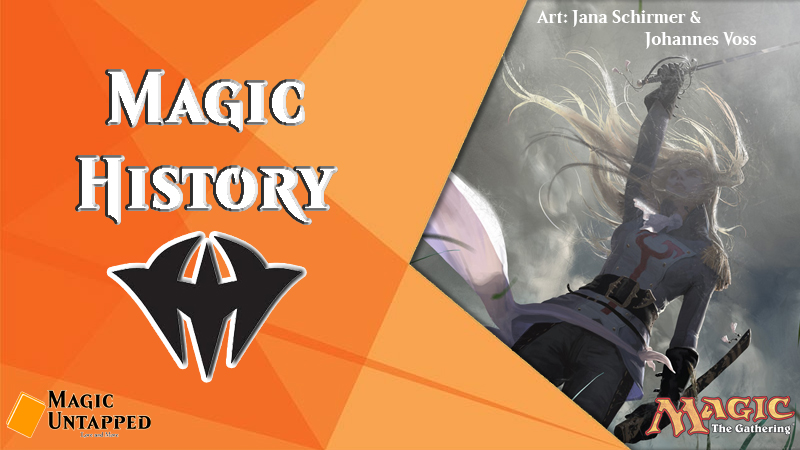Magic Untapped takes a look back at the set Dark Ascension.
After 30 years of Magic: The Gathering, it's nice to look back at older sets to reminisce and see just how much the game has changed over the years.
In this video, we look back at Dark Ascension, the second set in Magic: The Gathering's original Innistrad block. And joining as a special guest for this retrospective is Mark Rosewater, the game's head designer.
Check it out:
Video Transcript:
Dark Ascension, the 57th Magic: The Gathering expansion, came out February 3, 2012.
And, like its predecessor, Innistrad, it’s a top-down designed set based around gothic and traditional horror tropes and themes.
Storyline-wise, Dark Ascension focuses upon the plane being overrun by werewolves, vampires, zombies, and other nightmarish creatures as humanity fights a losing battle for survival.
<<Maro 20:24-20:35, 21:00-08 “The story of…up our story.” “So the idea of…brink of extinction.”>>
As for the full story of the Innistrad block, we recommend you check out our Innistrad Magic History video. We have a pretty good overall story summary for you there.
As for the 158-card Dark Ascension set itself, development was headed up by Tom LaPille, who was on the Innistrad design team. Mark Rosewater led Dark Ascension design.
<<Maro 3:36-4:05 “Innistrad and Dark Ascension…and the third set.”>>
Dark Ascension saw the return of double-faced cards, flashback, morbid, and curses from its predecessor while also adding in two new mechanics – the first of which being fateful hour.
<<Maro 21:08-24 “Fateful hour is the…plight of the humans.”>>
As for that second mechanic, it took some doing to figure out what it should be and how it should work.
<<Maro 21:31-22:29, 22:37-56 “What happened was…make a monster mechanic.” “In the movies…closest was persist.”>>
Persist uses -1/-1 counters, which was a problem seeing as Dark Ascension doesn’t use -1/-1 counters anywhere within the set. The simple solution? Lean into the set’s already existing +1/+1 counters instead.
<<Maro 23:36-24:09 “It dies and it…where undying comes from.”>>
The set also has five cycles:
- Increasing flashback cards, each of which have an ability that doubles when cast via flashback, such as with the card Increasing Savagery, which doubles the amount of +1/+1 counters it puts onto a target creature from five to ten;
- Allied flashback cards, each having a flashback cost of a color that is allied with the card’s actual color identity;
- Enemy flashback cards, which are similar to the set’s cycle of allied flashback cards, except that the flashback cost is in an enemy color rather than an allied one;
- Mythic rare tribal cards, which is a cycle of four (rather than the traditional five) cards that are associated with one of the four monster tribes associated with the plane of Innistrad, and;
- Tribal lords, another cycle of four cards that each provide some sort of beneficial buff and boon to their respective tribal cards.
And you might notice that, in those last two cycles, the green-white allied color pair was not represented. This was done to emphasize the monsters taking over as green-white was reserved for humans in the block.
<Maro 25:52-03 “The human one…in other sets.”>>
Oh, and there’s also a nifty vertical cycle mixed in with the cards Scorned Villager, Lambhold Elder, and Huntmaster of the Fells, each of which take inspiration from the Brothers Grimm fairy tail of Little Red Riding Hood, except for in this case all three cards turn into a big, bad wolf.
Beyond these cycles, Dark Ascension also has a number of other cards worth a mention, including:
- Elbrus, the Binding Blade, an equipment card that can turn into the game-finishing creature Withengar Unbound;
- Faithless Looting, a red card draw spell that would wind up being banned in August of 2019 in Modern thanks to its prevalence in a number of graveyard-focused strategies;
- Geralf’s Messenger, a 3/2 with undying for three black, it’s a life-attacking tempo card that gets stronger when it dies;
- Grafdigger’s Cage, a popular and powerful sideboard card against graveyard-focused strategies;
- Gravecrawler, a one-drop 2/1 creature that can be cast from the graveyard. It and the aforementioned Geralf’s Messenger were key components in the zombie tribal decks in Standard at the time;
- Huntsmaster of the Fells, which saw much competitive play in the day thanks to it gaining its caster life as well as being a formidable damage outlet;
- Lingering Souls, an uncommon that saw widespread use across a number of formats thanks to its ability to create a good number of creatures over the course of multiple turns;
- Mikaeus, the Unhallowed, a storyline-evolved version of the original Mikaeus legendary creature from Innistrad. The card is no stranger to Commander play;
- Thalia, Guardian of Thraben, a staple in Modern and Legacy Death & Taxes builds, and;
- Tragic Slip, a spot removal card that can get around indestructibility.
As for the set’s promotional cards, Dark Ascension had a few, including the card Ravenous Demon/Archdemon of Greed {the set’s prerelease promo) and Mondronen Shamen/Tovolar’s Magehunter (the set’s release promo). Game day attendees received a full-art Stranglerood Geist, while top-eight finishers also received a full-art foil Zombie Apocalypse. The set’s buy-a-box promo was an alternate-art Gravecrawler.
So, looking back, what does Mark Rosewater think about this middle set from the original Innistrad block?
<<Maro 13:50-14:33 “So, Dark Ascension…on this set.”>>
So, what are your thoughts on Dark Ascension? Let us know in the comment section below.
Thanks to Mark Rosewater for his time.
If you’d like to support Magic Untapped, please like this video and subscribe to the channel here on YouTube. Also, we have a tip jar on Patreon if you are feeling so generous.
Thanks for watching.









